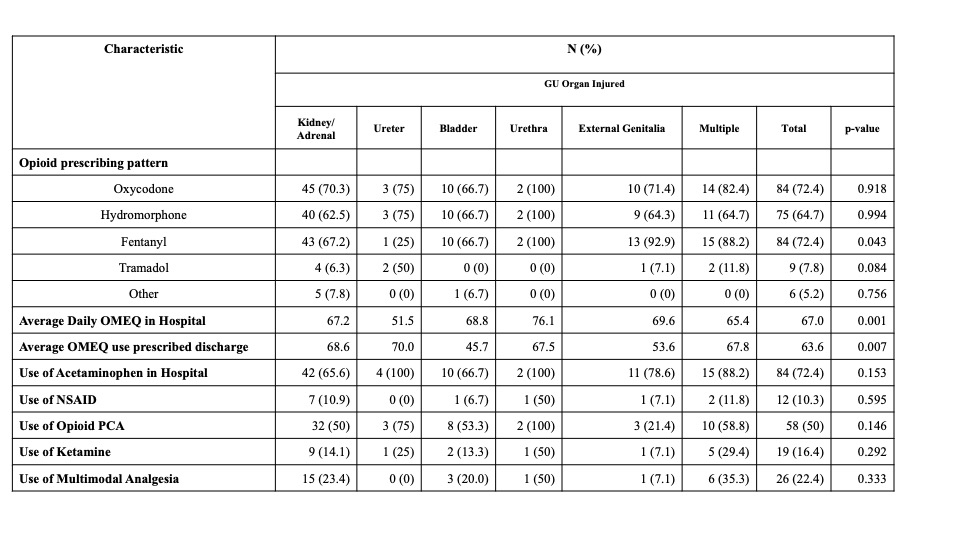Back
Poster, Podium & Video Sessions
Moderated Poster
MP20: Trauma/Reconstruction/Diversion: External Genitalia Reconstruction and Urotrauma (including transgender surgery) I
MP20-01: Opioid and Multimodal Analgesia Use Following Urological Trauma
Saturday, May 14, 2022
7:00 AM – 8:15 AM
Location: Room 225
Mary Rostom*, Andrew Gabrielson, Ryan Fransman, Shirley Wang, Albert Holler, Isabella Pan, Nikita Gupta, Joseph Sakran, Andrew Cohen, Baltimore, MD

Mary Rostom, BS
Johns Hopkins School of Medicine
Poster Presenter(s)
Introduction: Following trauma, increased opioid use is associated with inferior outcomes and increased risk of opioid dependence, particularly in vulnerable populations. In contrast, multimodal analgesia following trauma results in decreased pain and readmission. Currently there is a paucity of data describing opioid usage following urological trauma. We assess utilization of opioids and multimodal pain regimens following urologic trauma.
Methods: We retrospectively examined 121 patients hospitalized following urologic trauma from 2016-2021. Inpatient and discharge utilization of opioids, multimodal analgesia and length of stay were stratified by affected organ. Analyses were performed in STATA with p<0.05 reaching significance.
Results: 121 patients were assessed; affected organ and mechanism of injury are shown in Table 1. Displayed in Figure 1, though differences in average opioid morphine equivalence (OMEQ) per day are not significant (p = 0.368), bladder injuries incurred higher mean OMEQ than other urological injuries with 14 (88%) requiring surgery and 8 (50%) associated with pelvic fracture. ISS’s were significantly different between trauma groups (p=0.011) with multiorgan trauma having the highest average. In nearly all groups, OMEQ prescribed at discharge is less than average inpatient OMEQ. Shown in Table 2, 87 (73%) patients were given acetaminophen in the hospital, but only 12 (10%) used non-opioid NSAIDs despite significantly lower average OMEQ prescriptions per day with acetaminophen use (p = 0.009).
Conclusions: Multimodal analgesia is severely underutilized following urological trauma. Combined with the development of opioid tolerance over long hospital stays, this creates an avenue for opioid misuse following discharge and opportunities for improvement.
Source of Funding: None



Methods: We retrospectively examined 121 patients hospitalized following urologic trauma from 2016-2021. Inpatient and discharge utilization of opioids, multimodal analgesia and length of stay were stratified by affected organ. Analyses were performed in STATA with p<0.05 reaching significance.
Results: 121 patients were assessed; affected organ and mechanism of injury are shown in Table 1. Displayed in Figure 1, though differences in average opioid morphine equivalence (OMEQ) per day are not significant (p = 0.368), bladder injuries incurred higher mean OMEQ than other urological injuries with 14 (88%) requiring surgery and 8 (50%) associated with pelvic fracture. ISS’s were significantly different between trauma groups (p=0.011) with multiorgan trauma having the highest average. In nearly all groups, OMEQ prescribed at discharge is less than average inpatient OMEQ. Shown in Table 2, 87 (73%) patients were given acetaminophen in the hospital, but only 12 (10%) used non-opioid NSAIDs despite significantly lower average OMEQ prescriptions per day with acetaminophen use (p = 0.009).
Conclusions: Multimodal analgesia is severely underutilized following urological trauma. Combined with the development of opioid tolerance over long hospital stays, this creates an avenue for opioid misuse following discharge and opportunities for improvement.
Source of Funding: None




.jpg)
.jpg)